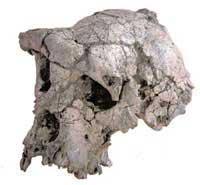Toumaï: hominid or monkey?
The skull of Toumaï was discovered in July 2001 in the Chad desert and last July the results of one year of research were published in the journal Nature. The head of the research was Michel Brunet, who stated that "Toumaïr's anatomy makes it clear that it belongs to the human branch and is separated from gorillas and chimpanzees. Moreover, it seems that we are very close to the separation between the chimpanzee and man." M. to perform these expressions Brunet was based on the research of the morphology of the skull, called outgoing front, nasal face and small teeth as unmistakable characteristics of the human being.

But not all paleontologists have coincided with these conclusions and have revealed that some of the features of Toumaïe's skull are closer to the families of the great monkeys. His last opinion was that of American paleontologist Milford Wolpoff in a letter sent to the journal Nature.
According to Milford Wolpoff, neither the pine forest of Toumaïn, nor the forehead, nor the occipital hole of the skull, indicate that it was the first species of the human branch of Sahelanthropus tchadensis. In addition, Wolpoff considers it a bipedal to ensure that Toumaï is a hominid. He adds that until confirmed, Toumaï will be considered a quadrupede.
In view of the controversial opinions of paleontologists, it seems that the debate will continue until more fossils are found to advance the study.
More information:
http://www.zientzia.net/artikulua. Artik_kod=6273
Buletina
Bidali zure helbide elektronikoa eta jaso asteroko buletina zure sarrera-ontzian











